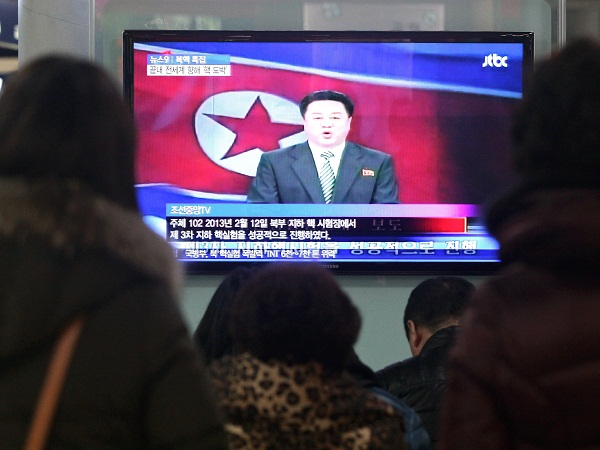With test, North Korea threat looks more real

South Koreans watch a TV screen showing a North Korean state television news on the country’s nuclear test, at the Seoul Railway Station in Seoul, South Korea, Tuesday, Feb. 12, 2013. North Korea defied U.N. warnings Tuesday by conducting an underground nuclear test in the remote, snowy northeast in what could be a crucial step toward its goal of building a bomb small enough to be fitted on a missile capable of striking the United States. AP/Ahn Young-joon
WASHINGTON—With a defiant nuclear test, North Korea has shown it poses an increasingly credible threat but some doubt whether even the notoriously bellicose regime would ever use weapons of mass destruction.
North Korea said it had miniaturized a nuclear device — critical to load a missile’s warhead. Experts are assessing whether the test involved uranium, giving Pyongyang a new, easier-to-sustain method alongside its plutonium.
While much remains murky about North Korea’s third nuclear test, analysts say North Korea succeeded in detonating a larger device, judging from the magnitude 5.1 seismic impact recorded Tuesday by nearby stations.
Columbia University seismologist Won-Young Kim said that the magnitude translated to a yield of 7.3 kilotons and showed, after lackluster tests in 2006 and 2009, that North Korea’s nuclear weapons program “is really working.”
Bruce Bennett, a senior defense analyst at the RAND Corporation, also said North Korea made a “pretty significant advance” from previous tests.
The yield would be roughly half that of the US bomb that killed 140,000 people in Hiroshima.
In December, North Korea put into orbit a small satellite on a rocket that fell near the Philippines.
The launch raised the prospect that North Korea, already able to hit US allies South Korea and Japan, could strike the US mainland.
The Institute for Science and International Security, a US think tank, said it would be no surprise if North Korea has miniaturized a nuclear device but doubted Pyongyang was able to deploy a warhead on an intercontinental missile.
But Bennett did not rule out that North Korea had lured a scientist from the former Soviet Union or elsewhere to build warheads.
“And so that raises a much more serious threat, even for the United States, at this stage,” he said.
North Korea, famous for its shrill tone, said it carried out the test in self-defense due to US “hostility” and to “demonstrate the might of the Koreans before the US which looks down upon them.”
It recently released a video — incongruously set to Michael Jackson’s “We Are The World” — that appeared to show a missile attack destroying New York.
Still, US policymakers and experts largely agree that the totalitarian regime’s main intention is not to start a war but to ensure its own survival and, in the process, extract concessions.
Heather Hurlburt, executive director of the left-leaning National Security Network, said that the latest test showed little new about the North Koreans unless it becomes clear that they switched to uranium.
Hurlburt saw the test in the context of young leader Kim Jong-Un as he navigates his relationship with the powerful military and sets the tone with incoming leaders in key neighbors China and South Korea.
“There is an inordinate amount of really problematic rhetoric and occasional provocations toward South Korea, which are not acceptable. But that’s dramatically different from the idea that they would do something as clearly suicidal as attack the United States,” she said.
Hurlburt said that the United States needed to show solidarity with its allies and ensure consequences for North Korea such as sanctions, but in the long term also consider positive incentives if Pyongyang changes course.
But Nicholas Eberstadt, a scholar at the conservative American Enterprise Institute, suspected that North Korea wanted to turn the tables and gain the capability to deter US actions, rather than the United States holding the deterrent.
“All of the talk about how this is to get the United States and others to the negotiating table, or about signaling, I think really misunderstands what’s going on here,” Eberstadt said.
“Outsiders seem not to understand what the North Koreans have been trying, sometimes very vividly as if they were talking to stupid children, to impart to us — which is that they are preparing to fight and win a limited nuclear war in the Korean peninsula.”
North Korea thrust itself onto the agenda hours before President Barack Obama delivered his State of the Union address, in which he proposed further cuts in nuclear weapons around the world.
Lawmakers of the rival Republican Party said that North Korea’s test showed problems in Obama’s approach. Some Republicans have pushed for the United States to redeploy nuclear weapons to South Korea, which were withdrawn in 1991.














